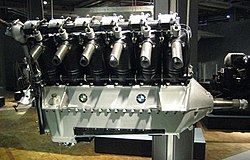BMW VI
| BMW VI | |
|---|---|
 A BMW VI in the German Museum of Technology in Berlin |
|
| Type: | Twelve-cylinder - V engine |
| Design country: | |
| Manufacturer: | |
| Production time: |
1926-1937 |
| Number of pieces: |
9200 |
The BMW VI (from 1933 BMW 106 with gasoline direct injection produces) was a liquid-cooled, twelve-cylinder engine - aircraft engine from BMW with a displacement of 46.9 liters.
The twelve-cylinder, which was built in series from 1926 to 1937, was the company's first V-engine and represented the final link of the older liquid-cooled BMW aircraft engines with individual cylinders.
history
After Junkers Flugzeugwerke had ordered 100 BMW IIIa engines in June 1923 , BMW resumed manufacturing aircraft engines.
The Reichswehr showed great interest in a twelve-cylinder engine and awarded BMW the official development contract in 1924. It was hoped that this would connect with the French and British twelve-cylinder aircraft engines - such as the Renault 12 Kb or the Napier Lion V - with outputs of over 450 hp.
The basis was the six-cylinder in-line BMW IV engine , which was expanded to include a further cylinder bank at an angle of 60 ° in accordance with a concept that was planned back in 1919 . The development under the direction of Max Friz was therefore already completed in 1925. On February 8, 1926, the engine received the type test from the German Aviation Research Institute (DVL) in Berlin-Adlershof and thus the approval for installation in German aircraft.
The BMW VI had the customary in aircraft engines Doppelzündanlage with two spark plugs per cylinder and two Bosch - magnetos with automatic or manual ignition timing. Starting was done either with a inertia starter or with compressed air. The pressure circulation lubrication was ensured by means of a gear pump . Each cylinder bank had a through vertical shaft driven overhead camshaft , the actuated per cylinder an inlet and outlet valve.
After the type approval, series production started in 1926. In 1930, BMW delivered the thousandth engine. In 1933 the first tests with direct petrol injection were carried out with this type .
The BMW VI was extremely economical and was considered very reliable. The German air Hansa used in Südatlantikverkehr flying boats of the type Dornier Do J "Wal" with this engine. The two Dornier Wal used by Amundsen on his Arctic expedition also flew with BMW VI engines. Thanks to the reliability of the engine, several record flights were achieved, such as the circumnavigation of the world in 1930 by Wolfgang von Gronau in a Dornier Wal. The rail zeppelin built in 1930 also had a BMW VI engine.
After BMW acquired the license to replicate the air-cooled nine-cylinder radial engine Pratt & Whitney R-1690 ( P & W Hornet A ) in the USA in 1928, production from 1933 concentrated on the BMW 132 developed from it and the construction of the BMW-VI Engines was discontinued in 1937.
The Auto- und Technikmuseum Sinsheim uses a BMW VI of the 8 series in its experimental vehicle " Brutus ".
There were license agreements with both Japan (as Kawasaki Ha-9) and the USSR , where the engine was manufactured as M-17 and M-17T . Of this alone, 27,534 pieces were produced in different versions between 1930 and 1942. From the M-17, the M-34 was developed by Alexander Mikulin , and series production began in 1932.
commitment
The BMW VI was used in the following aircraft, among others:
- Arado Ar 65
- Arado Ar 68
- Arado SSD I
- Beriev MBR-2
- Dornier whale
- Dornier Mercury
- Dornier dolphin
- Dornier Thursday 14
- Dornier Thursday 17th
- Dornier Thursday 23
- Focke-Wulf A 29
- Heinkel HE 5
- Heinkel HE 9
- Heinkel He 45
- Heinkel He 51
- Heinkel He 70
- Heinkel He 111
- Kawasaki Ki-10
- Kawasaki Ki-32
- Rohrbach Rofix
- Rohrbach Romar
- Tupolev TB-1
- Tupolev R-7
It was also used in armored vehicles as the Mikulin M-17T:
Technical specifications
The use of connecting rods results in a different stroke of the two cylinder banks, which is why the displacement of the original BMW IV engine more than doubles.
| Parameters | BMW VIu 7.3 data |
|---|---|
| design type | Twelve-cylinder V-engine (60 ° bank angle ), two valves per cylinder |
| drilling | 160 mm |
| Hub | 190/199 mm ( connecting rod ) |
| Displacement | 46.9 liters |
| increased short power | 750 hp (550 kW ) at 1700 min -1 |
| Continuous output | 585 hp (430 kW) at 1,350 min -1 |
See also
Web links
- BMW VI. In: BMW history. BMW AG, accessed on April 22, 2019 (dossier from the BMW Group Archives).
Individual evidence
- ^ BMW 106. In: BMW history. BMW AG, accessed on May 31, 2016 (document from the BMW Group archive): "Corresponds to the BMW VI aero engine with injection."
- ↑ a b Fred Jakobs: Mobile Tradition live: The BMW VI aero engine - propulsion of civil aviation. In: Mobile Tradition live - Issue 01/2005. BMW AG, 2005, pp. 12–17 , accessed on May 31, 2016 (document in the BMW Group Archive).
- ↑ Description and operating instructions for the Bayern aircraft engine BMW VI. In: BMW history. BMW AG, 1927, accessed on May 31, 2016 (document in the BMW Group Archive).
